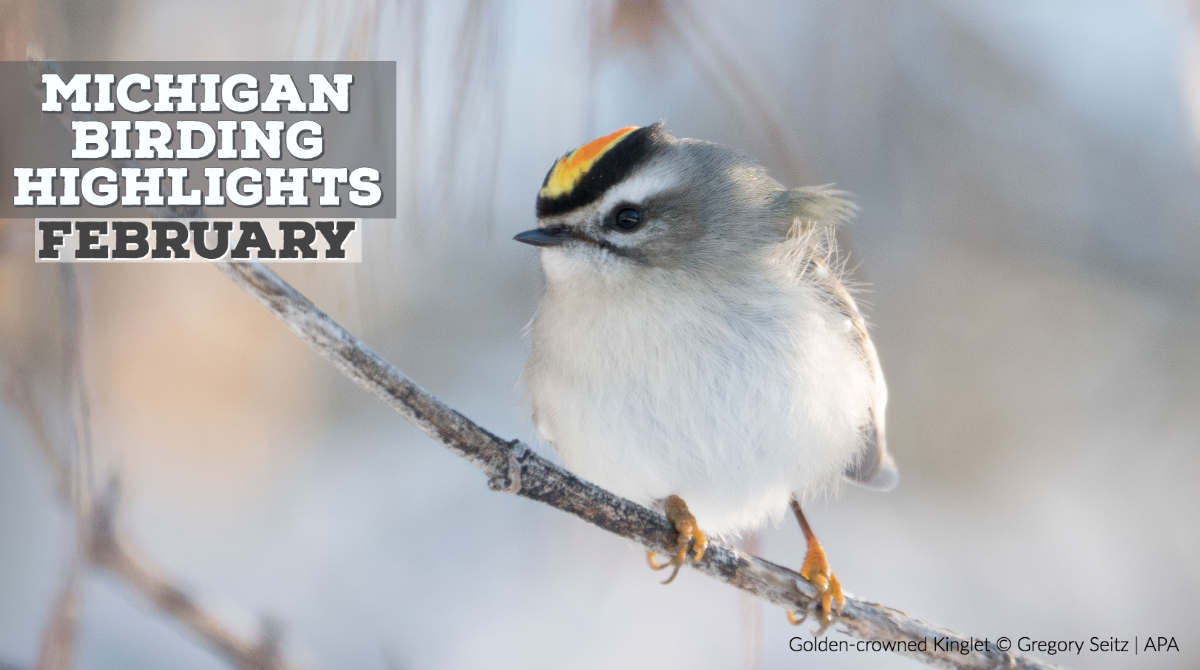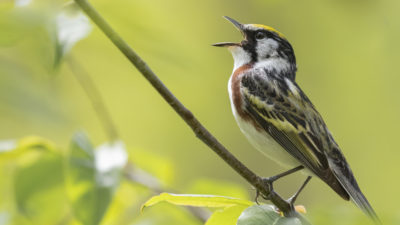
Chestnut-sided Warbler. Photo by J.A. Mikulich | MAPA
When it comes down to it, there’s always far more to say and share than is possible each month of this Michigan Birding Highlights post. Keeping up in the birding community is exciting — there are always new people to connect with, birds to see at home or chase across the state, or the next big migration movement to look forward to. Once again, I am sitting at home eagerly planning spring birding outings, yet it’s still the middle of winter! My spark bird (the species that inspired me to be a birder) was a Chestnut-sided Warbler. That and subsequent bird research positions monitoring different warbler species in all seasons has made me a warbler enthusiast (more on warblers in a future post). So I find myself each winter just getting ready for spring and not being present in the here and now. I see social media posts such as a Cerulean Warbler singing, which furthers my springtime pull.
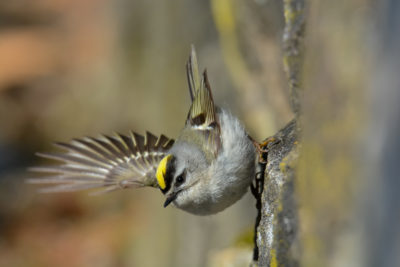
Golden-crowned Kinglet. Photo by Gordon Jesse | APA
There are benefits to both planning your future birding and birding here and now, of course; it’s exciting to have plans and goals to look forward to, and yet it’s also grounding to go out in the cold and snow to tally three species on a list and call it a good day. I did this just the other day — went out for a walk to stretch my legs midday, found a nice wooded patch in a local park, and during a 30-minute hike, I heard and saw only one small group of birds: a few Tufted Titmouse, a Black-capped Chickadee, and two Golden-crowned Kinglet. In the past week or two, winter birding has been enjoyable in this way, though, and I appreciate the single sightings that make an outing exciting. I found a small flock of Horned Lark in open fields while driving through the Michigan State University south campus. I also visited a site where Peregrine Falcon breed, and sure enough, one of the falcons was perched, as expected, on Lansing’s power plant stacks along the Grand River.
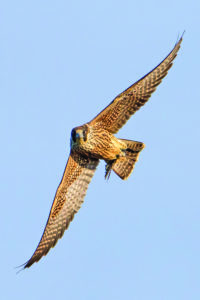
Peregrine Falcon. Photo by Josh Haas
Enough about Lansing, though — it’s time to talk about what you might expect to see in Michigan in February! I enjoy browsing through the various social media groups related to birding in Michigan and keeping tabs on the email listservs and eBird alerts. It’s a fun way to know what you are doing out there in Michigan and to hear about exciting bird sightings or behavior observations. If you’re not already connected to any of these groups, here are a few I recommend on Facebook:
There are so many more, ranging from basic bird identification help to technical eBird discussions. To find and subscribe to Michigan email listservs, visit birding.aba.org/ and scroll down to the Michigan lists.
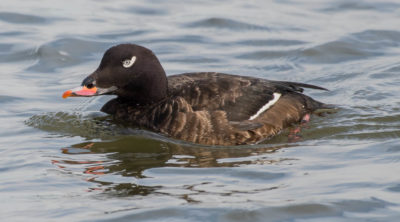
White-winged Scoter. Photo by Mark Schroeder | APA
A recent post I came across while following these various social media groups was about birding in Van Buren County. This relatively under-birded county is highlighted by Ken Bishop, a local birder, in his blog series (with hopes of starting a Van Buren Birding Trail). It’s great to read in detail about local hotspots and his tips for birds’ seasonality at specific local patches. In winter, an excellent place to bird is at locations where water stays open (unfrozen). You can find open water on larger bodies of water (e.g., Lake Michigan), on rivers that move enough to prevent ice formation, alongside dams, or near power plants. Along the Lake Michigan shoreline this time of year, you may find waterbirds such as Red-breasted Merganser, Common Goldeneye, and White-winged Scoter (especially in late winter), and keep an eye out for migrating waterbirds as February moves into March (and spring!). You never know what species you may find. It’s worth noting that you should go equipped with many warm layers! Check out the Van Buren Birding Trail blog here.
There are already several established birding trails in Michigan, each of which highlights a series of hotspots for birding in a county or local region; information and links to each birding trail’s website are summarized at michiganaudubon.org/go-birding/birding-trails/. Birding trails can be a great way to discover new places to go birding, whether in your local area or to explore a new part of the state. If you keep a list of bird species for the state or counties, they can also help you target areas to explore more in-depth to boost your species list.
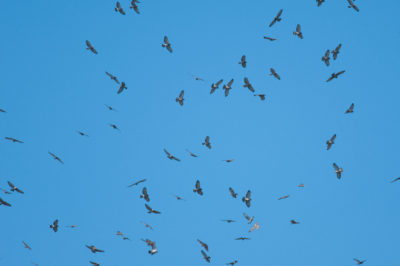
Broad-winged Hawk kettle. Photo by Nova Mackentley
A final thought as we move into February: This is a great time to brush up on your raptor identification skills! If you’re new to hawk watching or want to explore information about hawk watching for the coming spring migration season, the Hawk Migration Association of North America has great resources on their website.
Whitefish Point Bird Observatory’s spring raptor migration count begins on March 15. Many raptor species move through in smaller numbers at the start of the season, but March is when both Bald Eagle and Golden Eagle peak in their migration through Whitefish Point. We’ll explore more about raptors and migration movements in the next Michigan Birding Highlights post!
~Linnea Rowse, Michigan Audubon conservation program coordinator

